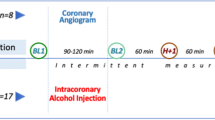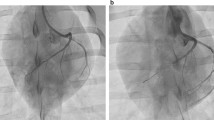Abstract
Current models for real time study of the effects of myocardial ischemia/reperfusion have major limitations and confounders. Confounders include the surgical stresses of a thoracotomy and abnormal physiology of an open chest. The need to reposition the animal interferes with the study of the early changes associated with ischemia. Direct comparison of pre-ischemia and post-ischemia images is then difficult. We developed a novel “closed chest” model of ischemia/reperfusion to overcome these issues. Following thoracotomy, we sutured a balloon occluder to the left coronary artery of male Sprague–Dawley rats. We used both visual inspection and ECG to assess for successful occlusion and reperfusion of the coronary artery at the time of operation by brief inflation and deflation of the balloon. The tubing was then placed under the skin and the incision closed. Following a recovery period (5–10 days), the animals underwent MRI. We performed baseline assessment of left ventricle function, and repeated LV measurement during a 15-min coronary occlusion and again during a 60-min reperfusion period following reopening of the coronary artery. The occluder was successfully placed in 40 of 44 animals. Four developed intraoperative complications; two large myocardial infarction, two terminal bleeding. Six died in the week following surgery, [four sudden deaths (presumed arrhythmic), one anterior infarction, one sepsis]. Cine-MRI demonstrated localised hypokinesia in 31 of the remaining 34 animals. LV ejection fraction (EF) was reduced from 63 ± 7 % at baseline, to 49 ± 9 % during coronary occlusion. LV EF recovered to 61 ± 2 %. The area at risk on staining of the heart was 41.9 ± 15.8 %. This method allows the effects of ischemia/reperfusion to be studied before, during, and after coronary occlusion. Ischemia can be caused while the animal is in the MRI. This new and clinically relevant small animal model is a valuable tool to study the effects of single or repeated coronary occlusion/reperfusion in real-time.




Similar content being viewed by others
Abbreviations
- AAR:
-
Area at risk
- EF:
-
Ejection fraction
- ECG:
-
Electrocardiogram
- LCA:
-
Left coronary artery
- LV:
-
Left ventricle
- MRI:
-
Magnetic resonance imaging
- I/R:
-
Myocardial ischemia/reperfusion
- TTC:
-
Triphenyltetrazolium chloride
References
Heimburger RF (1946) Injection into pericardial sac and ligation of coronary artery of the rat. Arch Surg 52:677–689
Selye H, Bajusz E, Grasso S, Mendell P (1960) Simple techniques for the surgical occlusion of coronary vessels in the rat. Angiology 11:398–407
Pfeffer MA, Pfeffer JM, Fishbein MC, Fletcher PJ, Spadaro J, Kloner RA, Braunwald E (1979) Myocardial infarct size and ventricular function in rats. Circ Res 44(4):503–512
Smith EF III, Egan JW, Bugelski PJ, Hillegass LM, Hill DE, Griswold DE (1988) Temporal relation between neutrophil accumulation and myocardial reperfusion injury. Am J Physiol 255(5 Pt 2):H1060–H1068
Michael LH, Entman ML, Hartley CJ, Youker KA, Zhu J, Hall SR, Hawkins HK, Berens K, Ballantyne CM (1995) Myocardial ischemia and reperfusion: a murine model. Am J Physiol 269(6 Pt 2):H2147–H2154
Sievers RE, Schmiedl U, Wolfe CL, Moseley ME, Parmley WW, Brasch RC, Lipton MJ (1989) A model of acute regional myocardial ischemia and reperfusion in the rat. Magn Reson Med 10(2):172–181
Himori N, Matsuura A (1989) A simple technique for occlusion and reperfusion of coronary artery in conscious rats. Am J Physiol 256(6 Pt 2):H1719–H1725
Messroghli DR, Nordmeyer S, Buehrer M, Kozerke S, Dietrich T, Kaschina E, Becher PM, Hucko T, Berger F, Klein C, Kuehne T (2011) Small animal look-locker inversion recovery (SALLI) for simultaneous generation of cardiac T1 maps and cine and inversion recovery-prepared images at high heart rates: initial experience. Radiology 261(1):258–265. doi:10.1148/radiol.11101943
Schwarz ER, Somoano Y, Hale SL, Kloner RA (2000) What is the required reperfusion period for assessment of myocardial infarct size using triphenyltetrazolium chloride staining in the rat? J Thromb Thrombolysis 10(2):181–187. doi:10.1023/A:1018770711705
Chien GL, Wolff RA, Davis RF, van Winkle DM (1994) “Normothermic range” temperature affects myocardial infarct size. Cardiovasc Res 28(7):1014–1017
Triana JF, Li XY, Jamaluddin U, Thornby JI, Bolli R (1991) Postischemic myocardial “stunning”. Identification of major differences between the open-chest and the conscious dog and evaluation of the oxygen radical hypothesis in the conscious dog. Circ Res 69(3):731–747
Jolly SR, Kane WJ, Hook BG, Abrams GD, Kunkel SL, Lucchesi BR (1986) Reduction of myocardial infarct size by neutrophil depletion: effect of duration of occlusion. Am Heart J 112(4):682–690
Bohl S, Medway DJ, Schulz-Menger J, Schneider JE, Neubauer S, Lygate CA (2009) Refined approach for quantification of in vivo ischemia-reperfusion injury in the mouse heart. Am J Physiol Heart Circ Physiol 297(6):H2054–H2058. doi:10.1152/ajpheart.00836.2009
Nossuli TO, Lakshminarayanan V, Baumgarten G, Taffet GE, Ballantyne CM, Michael LH, Entman ML (2000) A chronic mouse model of myocardial ischemia-reperfusion: essential in cytokine studies. Am J Physiol Heart Circ Physiol 278(4):H1049–H1055
Fu Y, Wang Z, Chen WL, Moore PK, Zhu YZ (2007) Cardioprotective effects of nitric oxide-aspirin in myocardial ischemia-reperfused rats. Am J Physiol Heart Circ Physiol 293(3):H1545–H1552. doi:10.1152/ajpheart.00064.2007
MacLeod BA, Augereau P, Walker MJ (1983) Effects of halothane anesthesia compared with fentanyl anesthesia and no anesthesia during coronary ligation in rats. Anesthesiology 58(1):44–52
Acknowledgments
The authors wish to thank Ulrich Rudolf Kemnitz for his invaluable assistance with the animal experiments.
Conflict of interest
DOH is funded by a Sachmittelbeihilfe of the Deutsche Forschungsgemeinschaft (DFG) granted to DM. The authors have no other relevant disclosures.
Author information
Authors and Affiliations
Corresponding author
Electronic supplementary material
Below is the link to the electronic supplementary material.
Movie 1
Short axis Cardiac MRI cine that demonstrates normal LV function before coronary occlusion (MPG 626 kb)
Movie 2
Short axis Cardiac MRI cine that demonstrates an area of localised hypokinesia in the LV during inflation of the coronary occluder. (MPG 690 kb)
Rights and permissions
About this article
Cite this article
O h-Ici, D., Jeuthe, S., Dietrich, T. et al. Closed-chest small animal model to study myocardial infarction in an MRI environment in real time. Int J Cardiovasc Imaging 31, 115–121 (2015). https://doi.org/10.1007/s10554-014-0539-0
Received:
Accepted:
Published:
Issue Date:
DOI: https://doi.org/10.1007/s10554-014-0539-0




